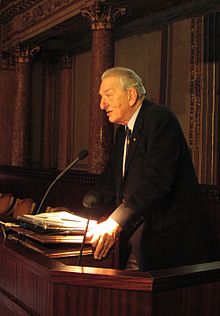George Olah
| George Andrew Olah | |
|---|---|
 |
|
| Born | Oláh György May 22, 1927 Budapest, Hungary |
| Died | March 8, 2017 (aged 89) Beverly Hills, California, U.S. |
| Citizenship | Hungarian and American |
| Fields | Chemistry |
| Institutions | |
| Alma mater | Budapest University of Technology and Economics |
| Known for | Carbocations via superacids |
| Notable awards |
|
| Spouse | Judith Lengyel (m. 1949) |
| Children | 2 |
George Andrew Olah (born Oláh György; May 22, 1927 – March 8, 2017) was a Hungarian and American chemist. His research involved the generation and reactivity of carbocations via superacids. For this research, Olah was awarded a Nobel Prize in Chemistry in 1994 "for his contribution to carbocation chemistry." He was also awarded the Priestley Medal, the highest honor granted by the American Chemical Society and F.A. Cotton Medal for Excellence in Chemical Research of the American Chemical Society in 1996.
Olah was born in Budapest, Hungary, on May 22, 1927, to Magda (Krasznai) and Gyula Oláh, a lawyer. After the high school of Budapesti Piarista Gimnazium (Scolopi fathers), he studied under organic chemist Géza Zemplén at the Technical University of Budapest, now the Budapest University of Technology and Economics, where he earned M.S. and Ph.D degrees in Chemical Engineering. From 1949 through 1954, he taught at the school as a professor of organic chemistry. In the subsequent two years, from 1954–1956, he worked at the Research Institute of the Hungarian Academy of Sciences, where he was Associate Scientific Director and Head of the Department of Organic Chemistry.
As a result of the 1956 Hungarian Revolution, he and his family moved briefly to England and then to Canada, where he joined Dow Chemical in Sarnia, Ontario, with another Hungarian chemist, Stephen J. Kuhn. Olah's pioneering work on carbocations started during his eight years with Dow. In 1965, he returned to academia at Case Western Reserve University in Cleveland, Ohio, chairing the Department of Chemistry from 1965 to 1969, and from 1967 through 1977 he was the C. F. Maybery Distinguished Professor of Research in Chemistry. In 1971, Olah became a naturalized citizen of the United States. He then moved to the University of Southern California in 1977.
...
Wikipedia
